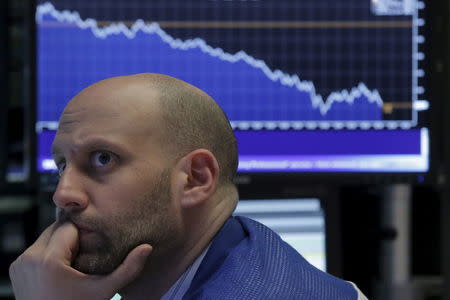Top 5 Things That Moved Markets This Past Week

Investing.com – Top 5 things that rocked U.S. markets this week.
1. US Equity Markets on Path to Test ‘Powell Put’
A few turns higher in volatility as measured by the so-called fear index VIX triggered short-lived panic selling but similar to last week traders were prepared to buy the dips.
That helped the benchmark US equity markets score a second weekly win – the first time since Jan. 26 – suggesting that the recent selloff was a correction and not the start of a prolonged bear market as some had initially feared.
Falling bond yields were also said to have supported sentiment on equities this week as 10-year yields eased from a four-year highs. But others, warned, however, that with bond yields within touching distance of 3% equities could be set for a tough slog higher.
CNBC reported, citing a note from Thomas Lee, founder and head of research at Fundstrat Global Advisors, that 10-year yields at 3% “intersects a trendline that has led to crashes or bear markets since 1980.” The key difference now, however, was that interest rates are coming off record lows and “like 1950s to 1960s, this period saw higher rates [and] higher equity prices."
The Dow Jones bagged 347 points on Friday en route to a two-week winning streak.
2. WTI Crude Added To Last Week’s Gains
Crude oil prices settled higher this week after US crude supplies unexpectedly fell for the first time in four weeks while Libyan oil production also lifted sentiment.
The fall in crude supplies was made all the more surprising as traders were expecting weaker refinery activity – which usually lowers demand for crude – would add to supplies. Some said, however, that the draw in crude supplies came amid added incentive to sell rather than store crude as current prices traded at a premium to forward prices – a market structure known as backwardation.
Rising US output, meanwhile, showed little sign of abating as Baker Hughes reported Friday the number of US oil rigs rose for the fifth-straight week. The rise in oil rigs came a few days after the EIA reported crude production remained close to record levels at 10.27 million barrels a day.
On Friday U.S. crude futures rose 78 cents to settle at $63.55 a barrel.
3. Political Uncertainty Left Euro Nursing Weekly Loss
EUR/USD ended the week nursing losses amid political uncertainty in the Eurozone as traders fretted the outcome of the upcoming Italian election less than two weeks.
Mizuho bank said safe haven demand grew Thursday, leading to an uptick in Treasuries and Bunds, as Italian election polls indicated the Five Star Movement is in the lead and a hung parliament potentially looms.
GBP/USD also suffered a weekly loss after Q4 UK GDP was revised lower, reflecting a sluggish economy at a time when Brexit related uncertainty is muddying consumer and business confidence.
4. Gold Prices Struggled Amid Dollar Delight
A rising dollar pressured gold prices to a weekly loss as the Fed’s minutes and monetary policy report released this week did little to jeopardize investor expectations of a March rate hike.
The Fed’s monetary policy report suggested the central bank – under the new leadership of Jerome Powell – remained content with its gradual approach to rate hikes. Fed chair Jerome Powell is expected to testify before Congress next week Feb. 27.
Bank of Montreal (BMO) said it doesn’t expect any material change in the official tone from the Federal Reserve as the best near-term outcome for Powell is policy continuity until there is “clear evidence” that inflation is overheating or the real economy is stumbling.
5. Bitcoin: Where Art Thou, Hodlers?
Bitcoin came under remained as the latest wave of selling saw traders ditch the “hodl” – the stock market equivalent term of ‘buy and hold.’
This week saw the return of central bankers jawboning on the need to curb bitcoin activity with Bank of England governor Mark Carney telling Reuters that bitcoin has “pretty much failed” as a currency. He further added that it was not a store of value because it is “all over the map.”
While there wasn’t a clear reason for the latest selloff in the land of cryptos, some said bitcoin’s rise close to $12,000 was met with technical resistance – trading levels that trigger selling.
Whether bitcoin’s latest plunge was on regulatory fears or technical resistance doesn’t really matter as traders responded in the same way: slashing their bullish bets on crypto. This was evident by the steep fund outflows close to levels last seen at the depths of the previous ‘bloodbath,’ when bitcoin fell to $6,000.
The total cryptocurrency market cap fell to about $446 billion, at the time of writing, down 13% from this week’s high of roughly $510 billion.
Bitcoin’s total losses over the last seven days was roughly 1% on the bitfinex exchange.
Related Articles
Dropbox files for IPO of up to $500 million
Volkswagen settles U.S. diesel owner lawsuit on eve of trial

 Yahoo Finance
Yahoo Finance 